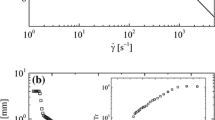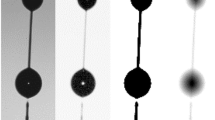Abstract
The penetration of long gas bubble through a viscoelastic fluid in a capillary tube has been studied in order to investigate the influence of viscoelastic material properties on the hydrodynamic coating thickness and local flow kinematics. Experiments are conducted for three tailored ideal elastic (Boger) fluids, designed to exhibit similar steady shear properties but substantially different elastic material functions. This allows for the isolation of elastic and extensional material effects on the bubble penetration process. The shear and extensional rheology of the fluid is characterized using rotational and filament stretching rheometers (FSR). The fluids are designed such that the steady-state extensional viscosity measured by the FSR at a Deborah number (De) greater than 1 differs over three orders of magnitude (Trouton ratio = 103–106). The experiment set up to measure the hydrodynamic coating thickness is designed to provide accurate data over a wide range of capillary numbers (0.01 < Ca < 100). The results indicate that the coating thickness in this process increases with an increase in the extensionally thickening nature of the fluid. Experiments are also conducted using several different capillary tube diameters (0.1 < D < 1 cm), in order to compare responses at similar Ca but different flow De. Suitable scaling methods and nonlinear viscoelastic constitutive equations are explored to characterize the displacement process for polymeric fluids. Bubble tip shapes at different De are recorded using a CCD camera, and measured using an edge detection algorithm. The influence of the mixed flow field on the bubble tip shape is examined. Particle tracking velocimetry experiments are conducted to compare the influence of viscoelastic properties on the velocity field in the vicinity of the bubble tip. Local shear and extension rates are calculated in the vicinity of the bubble tip from the velocity data. The results provide quantitative information on the influence of elastic and extensional properties on the bubble penetration process in gas-assisted injection molding. The bubble shape and velocity field information provides a basis for evaluating the performance of constitutive equations in mixed flow.
Similar content being viewed by others
Author information
Authors and Affiliations
Additional information
Received: 19 January 1999 Accepted: 30 June 1999
Rights and permissions
About this article
Cite this article
Gauri, V., Koelling, K. The motion of long bubbles through viscoelastic fluids in capillary tubes. Rheol. Acta 38, 458–470 (1999). https://doi.org/10.1007/s003970050197
Issue Date:
DOI: https://doi.org/10.1007/s003970050197




